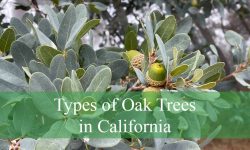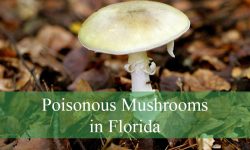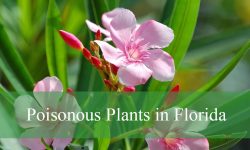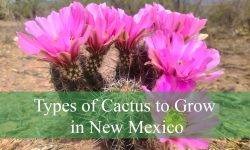The beauty of roses is mirrored in a wide variety of stunning blooms in the enchanted realm of flora. The world of flowers offers a variety of 25 gorgeous blossoms that nearly resemble the classic beauty of roses, from the sumptuous peonies to the graceful camellias, and the vivid chrysanthemums to the delicate lisianthus. Discover the fascinating diversity that nature has to offer as we take you on a journey through this breathtaking selection of floral beauties, each showcasing its own charm and allure reminiscent of the beloved rose.
The beauty and meaning of roses?
Roses have long been cherished for their unparalleled beauty and rich symbolism. Beyond their captivating aesthetics, these flowers convey a multitude of emotions and sentiments, ranging from love and passion to gratitude and remembrance. They serve as timeless messengers of affection, making them an enduring symbol of romance and devotion. Additionally, different colored roses carry distinct meanings, with red roses symbolizing love and desire, white roses representing purity and innocence, and yellow roses conveying friendship and joy. As such, roses hold a special place in the heart of many, serving as a timeless emblem of heartfelt emotions and profound connections.
Different types of Flowers that look like Roses
1. Chinese Bush Cherry
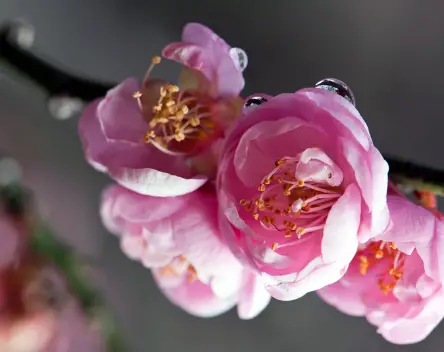
The Chinese bush cherry, or Prunus glandulosa, is a small tree that grows to a height of five to twelve feet. It has pink or white blossoms that resemble roses in the spring and turns orange in the fall. It is a member of the Rosaceae family and grows best in zones 4 through 8, with full sun and rich, well-drained soil. Watering on a regular basis is required until established.
2. Japanese Flowering Cherry
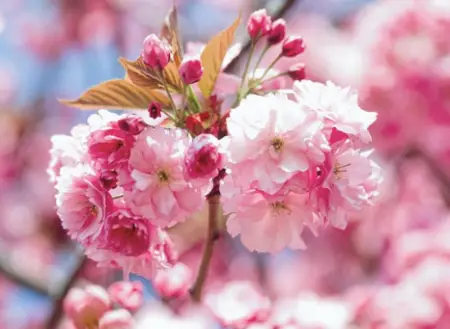
China, Japan, and Korea are the birthplaces of the Japanese flowering cherry (Prunus serrulata), which grows best in zones 4 through 9. Reaching 15 to 25 feet in height, these deciduous trees are prized for their breathtaking pink and white blossoms that appear in late winter and early spring. They have an average lifespan of 20 years. They grow best in well-drained, wet soil and prefer full sun or partial shade. These gorgeous but low-maintenance plants mimic roses and are quite striking.
3. Flowering quince
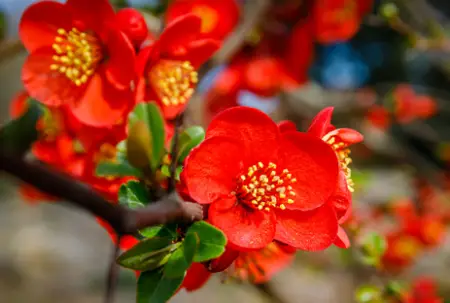
The flowering quince, or Chaenomeles japonica, is a deciduous shrub native to Southeast Asia that has small fruits and rose-like flowers that are pink, red, and white. These bushes, which may grow up to 10 feet tall and wide, are frequently used to create barriers and hedges. Growing easily in full sun and somewhat acidic soil, they require little care, much like roses.
4. Shrubby Cinquefoil
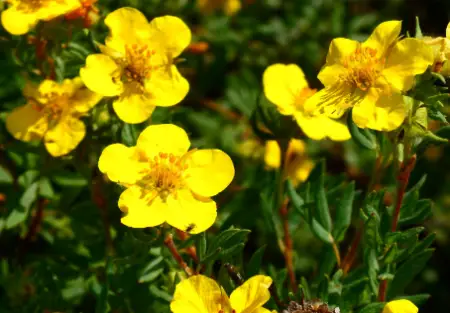
Zones 3 through 7 are ideal for shrubby cinquefoil (Potentilla fruticose), a deciduous shrub native to Northern Asia, Europe, and North America. It is two to four feet tall, with little yellow flowers that resemble wild roses. Similar to roses, these low-maintenance shrubs display vivid hues from late spring to fall.
5. Lisianthus
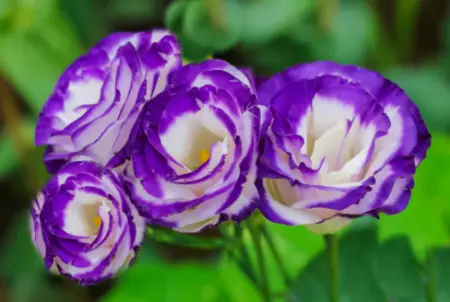
North American herbaceous perennial Lisianthus (Eustoma grandiflorum), sometimes known as prairie gentian, is known for its magnificent rose-like blossoms that come in a variety of colors, including pink, white, blue, purple, and green. Because they may be used year-round, especially in bridal bouquets, these flowers are often used in cut arrangements. They can reach a height of three feet and grow best in sunny, well-drained soil that retains moisture.
6. Weigela bush
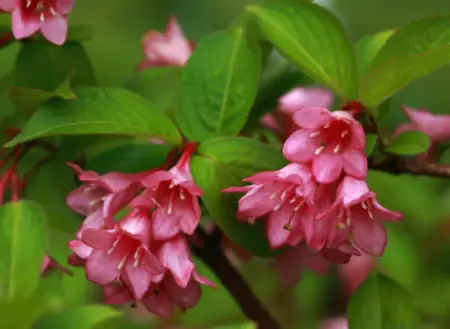
East Asian weigela is a flowering deciduous shrub that grows to a height of 6 to 10 feet. It does well in zones 4 through 8. It thrives on soil that is well-drained, wet, and nutrient-rich, preferring full sun to partial shade. Similar to roses, weigela bushes attract a variety of pollinators and can be a spectacular yet low-maintenance addition to the landscape with their little pink or yellow blooms that bloom from spring to summer.
7. Magnolia
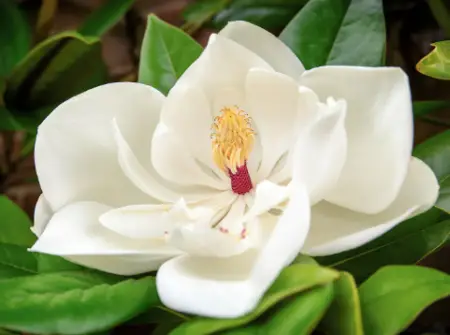
Sweet bay, or magnolia (Magnolia virginiana), is another name for this evergreen tree that grows best in zones 5 through 10 and is indigenous to the eastern seaboard of the United States. These trees may grow up to 50 feet tall, and their brilliant red fruits attract birds. They have white rose-like blossoms that bloom in the early summer with a citrus aroma. They love full sun to moderate shade and grow best in acidic, well-drained soil. They require frequent watering until they get established, after which they can withstand droughts.
8. Oriental Poppy
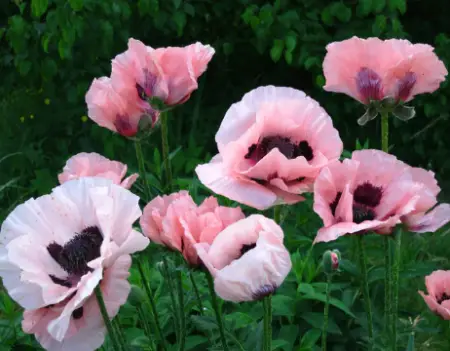
Originating in eastern Europe and Asia, the oriental poppy (Papaver orientale) has a long and illustrious history of cultivation spanning over 3000 years. These vivid flowers, which resemble roses, grow best in sunny, well-drained areas. They have bright hues including orange, red, pink, purple, and white when they bloom, which lasts from late spring until midsummer. They become dormant in the summer and then come back in the fall. In the winter, they produce clusters of foliage, and in the spring, flower spikes appear.
9. Double tulips
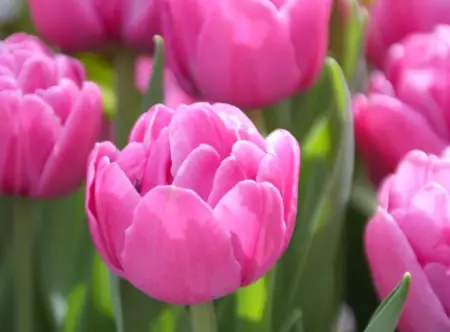
Nurseries develop the hybrid variety known as double tulips, which have large, open blooms with two petals. Originating in the Mediterranean and Eurasia, they are found in zones 3 to 8, where they produce striking spring flowers in colors ranging from bicolor to red, white, pink, yellow, and orange. When planted in full sun, these tulips, which resemble roses or peonies, can reach a height of 22 inches. Growing from bulbs, they like rich, well-drained soil and consistent irrigation.
10. Tuberous Begonias
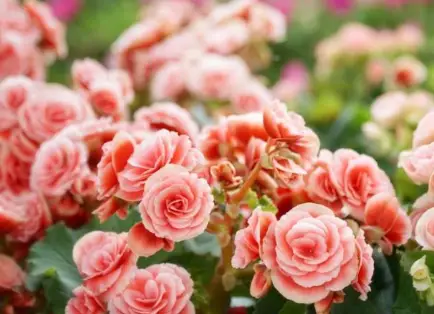
Native to South America and southern Africa, tuberous begonias are now widely cultivated. The hybrid cultivar Begonia × tuberhybrida has enormous, spectacular blooms with thick, waxy petals that resemble roses in colours of pink, red, orange, yellow, and white. Zones 9 through 11 are best for these plants, which prefer dappled shade and rich, well-drained soil with lots of compost. Grown largely as annuals, tuberous begonias bloom from summer to fall and can grow up to 1.5 feet tall. They demand a lot of maintenance.
11. Rose of Sharon

Though it may not seem like a rose, the rose of Sharon (Hibiscus syriacus) is a huge blooming shrub that, like roses, lends structural elegance to gardens. Grows in full sun or light shade, with magnificent pink, red, white, and yellow flowers with a vivid pink center. Although it can tolerate drought and poor soil, it prefers lush, humid environments. It is native to China, India, and other East Asian countries; zones 5 to 8 are usually used for cultivation.
12. Double Zinnia
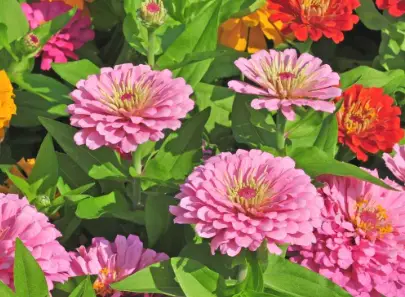
South American natives Zinnia marylandica, or double zinnias, are well-known for their double layers of rose blossoms. Unlike roses, these annuals are simple to grow from seed. They thrive in zones 2 through 11, and they can withstand poor soil conditions as long as the land is well-drained and moderately watered. They grow to a height of around 20 inches and have huge pink blooms from summer to fall that are showcased by clumps of green leaves.
13. Busy Lizzy

Originating in East Africa, Busy Lizzy (Impatiens walleriana) is a double-flowering impatiens that brings brilliant colors to gardens in the late spring, summer, and fall. They thrive in zones 2 through 11, and they can withstand the winter in zones 10 and 11. They like shaded areas with rich, well-drained soil. These impatiens, which resemble roses, can grow up to two feet tall and bloom in a variety of red, pink, purple, and orange hues.
14. Hydrangeas
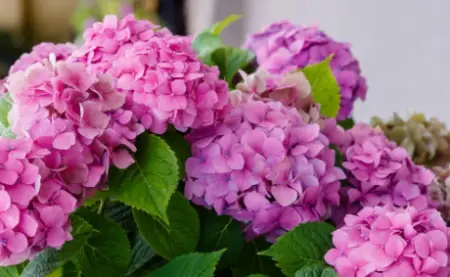
Like roses, hydrangeas (Hydrangea macrophylla) are traditional garden plants that are prized for their cut flowers. They are native to China and Japan and grow best in zones 5 through 11, with a profusion of pink, white, purple, red, and blue umbellate inflorescences. These shrubs are deciduous and thrive in regions that are partially or completely shaded with well-drained, moist soil. They bloom in the summer and lose their leaves in the winter. The blossoms become pink in alkaline soil and blue in acidic soil. Large bushes with a height and width of six to ten feet can be achieved by hydrangeas.
15. Gardenias
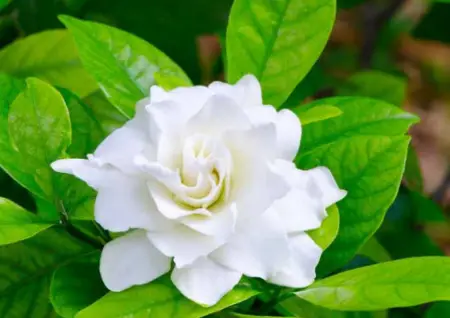
Gardenias are evergreen bushes with rose-like characteristics that are native to China and Japan. These hardy perennials have enormous, fragrant blooms with creamy-white to buttery yellow petals that appear for weeks in late spring and summer. Zones 6 through 11 are good for a variety of cultivars; Gardenia Grandiflora can grow to a height of about 8 feet. They are drought-intolerant and need regular rainfall to thrive in acidic, well-drained soil.
16. Wild Dahlia
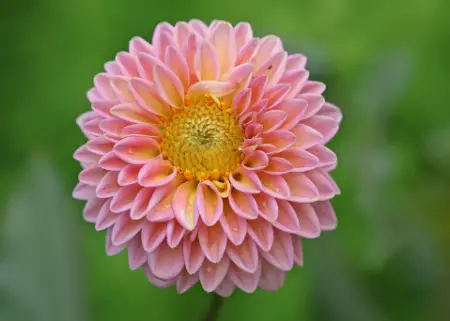
Native to Mexico, wild dahlias like warm, muggy weather. The perennial Dahlia sorensenii has lavender-pink petals with a yellow center that resemble wild roses. These plants have long stems that make them ideal for cut arrangements, and they can grow to a height of over 4 feet. Dahlias, in contrast to roses, are grown from bulbs, which are best planted in the spring for late summer and fall flowering. Though they are considered annuals in zones 7 through 10, intense heat can cause them to become perennials. They prefer moist, well-drained soil and grow well in full light.
17. Carnations
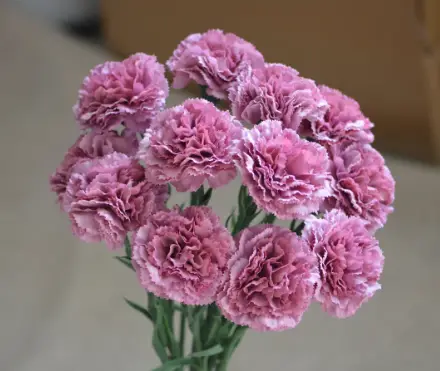
Native to the Mediterranean, carnations (Dianthus caryophyllus) have been farmed for more than two millennia. Throughout the summer, these herbaceous perennials display frilly rosettes of petals with colors ranging from pink and purple to white, red, yellow, and purple. Their fragrant blossoms make them a florist’s favorite; their tall, straight stems, which reach heights of 15 to 18 inches, symbolize love and good fortune. Growing in zones 3 through 9, they like full sun and can handle many kinds of well-drained soil. They need to be well-watered, but they also need to let the soil dry in between applications.
18. Japanese Anemones
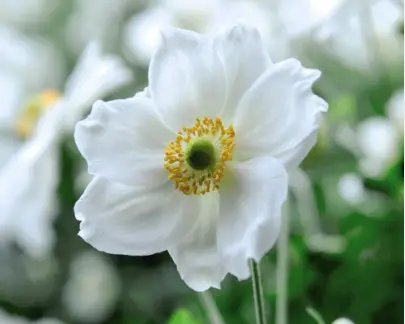
Chinese natives are the natives of the family Ranunculaceae, which includes Japanese anemones (Anemone hybrida). Large, open flowers in pink and white that resemble poppies, buttercups, peonies, and roses are produced by these perennials. They grow to a height of three to four feet, and bloom from summer through fall. Double and single flowering types are available. They do best in zones 4 through 9, with wet, well-drained soil that receives either full sun or light shade. They need to be divided roughly every three years after they are established, which takes around two years.
19. Buttercups
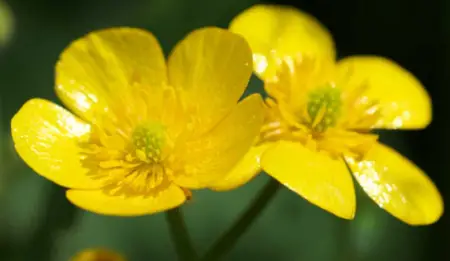
Buttercups are herbaceous perennials with flowers that resemble roses. They are members of the Ranunculus genus. They are found throughout North America, Europe, Asia, and northwest Africa in damp, somewhat shaded woodland regions. Cultivated hybrids resemble peonies and roses, with huge, multilayered, ribbon-like blooms in reds, pinks, white, and yellow, while wild varieties have tiny, single-layered, yellow flowers. When planted as bulbs in the spring, they blossom into the summer. Appropriate for zones 4 through 11, they thrive in full sun to partial shade and require winter protection in cold locations. They also prefer well-drained soil.
20. Azaleas or Rhododendrons
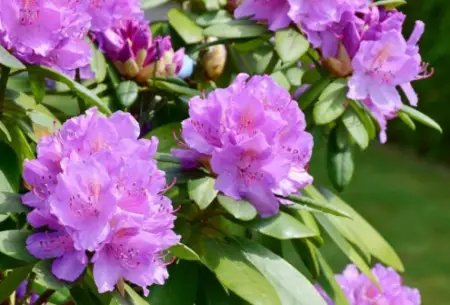
The Rhododendron genus, which includes Azaleas and Rhododendrons, are evergreen flowering plants. Rhododendron ferrugineum is also referred to as alpenrose or snow-rose. They grow best in zones 3 to 9, and they are native to eastern Europe, Asia, and North America. They have trumpet-shaped clusters of colorful blooms in shades of pink, white, red, yellow, and violet that bloom for a long time, from spring to summer, much like roses. Depending on training and trimming, these shrubs can grow to heights of one to twenty-five feet. They prefer rich, well-drained soil that is somewhat acidic (pH of 5), dappled shade, and lots of mulch. During flowering, they need to be thoroughly watered.
21. Camellias
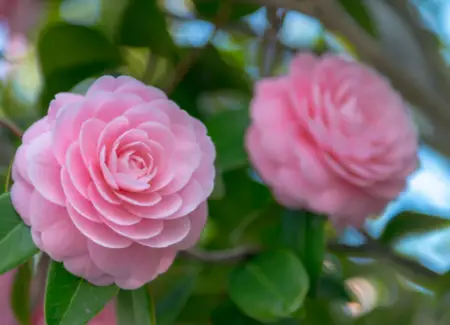
Originating in eastern and southern Asia, camellias are evergreen shrubs with the potential to grow up to 60 feet tall trees. It is well known that Camellia sinensis produces tea leaves. Since they were first introduced to European gardens in 1739, there have been several commercial and ornamental cultivars that have flourished in zones 6 to 9. Large, smooth pink and white petals with a rose-like peony-like appearance are seen in both single- and double-flowering variants. If many varieties are planted, their staggered flowering allows for year-round displays. Like roses, they thrive in acidic, organic-rich soil, withstand drought, require little watering, and grow best in shadow or partial light. They are low-maintenance landscape shrubs.
22. Peonies
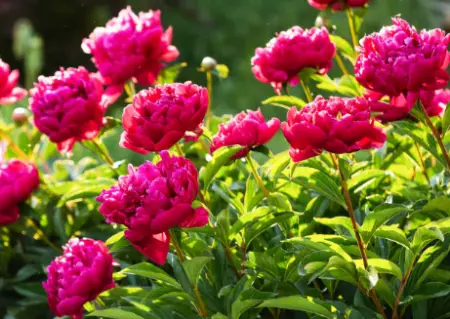
Similar to roses, peonies (Paeonia officinalis) are traditional garden flowers. They have huge, luxuriant blooms with a lovely aroma. They are available in pink, white, yellow, and red hues, with dense ruffling and comparable petal shapes. These herbaceous perennials, which are indigenous to western North America, Asia, and Europe, bloom from early spring to summer. They are commonly grown from bare roots in zones 3 to 8, and they do best in full sun and well-draining soil.
They benefit from pruning to maintain adequate air circulation because they are susceptible to fungal diseases like botrytis and need a cold winter to generate buds. Peonies usually reach heights of three to four feet and are generally hardy and low-maintenance plants.
23. Chrysanthemum
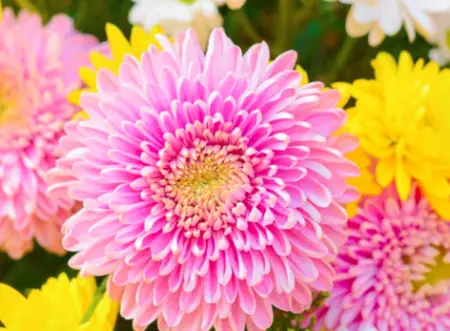
There are more than 20,000 different types of Chrysanthemum indicum! The “single” variety is a wonderful cut flower that emulates the beauty of roses. These multi-petaled blooms come in tones of pink, white, red, and yellow and bloom in the fall. They can be grown as annuals as well. Chrysanthemums are native to northeastern Europe and East Asia, and they grow well in zones 5 through 9, becoming compact shrubs that are roughly three feet tall and wide. Although they do well in a variety of soil types, they like sunny spots and do best in soil that is wet and well-draining.
24. Ornamental Pear
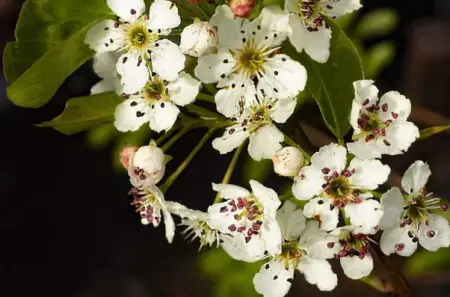
Throughout the winter and spring, the deciduous ornamental pear tree (Pyrus calleryana) adorns itself with masses of white blossoms that resemble roses. This tree does not bear fruit. It is related to roses and grows best in zones 4 through 8 of the Rosaceae family. It grows well in a variety of soil types and can withstand hot, dry weather, though it likes soil that is moist and drains well. Its verdant foliage changes to hues of purple, scarlet, and golden as fall approaches. It can grow up to 40 feet tall, depending on the variety.
25. Ornamental Apple
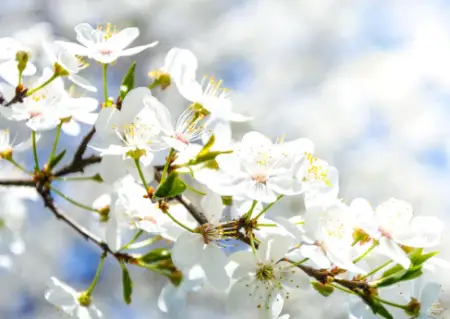
Reaching up to 20 feet in height, the ornamental apple tree (Malus sargentii), native to Japan, is a compact tree perfect for small gardens or pots. Its shape, bushy and hedge-like, adds to its allure. The tree is covered in an abundance of rose-like red, pink, and white blooms throughout the spring. Autumn offers blazing red hues to the foliage, while winter brings little fruits that draw lots of birds. Grown in either full sun or light shade, it thrives in a variety of soil types. These sturdy, cold-hardy trees are simple care; they just need the occasional pruning to keep their shape. For optimum development, apply compost in the fall and organic fertilizer in the spring.
People Who Read This Also Read:

